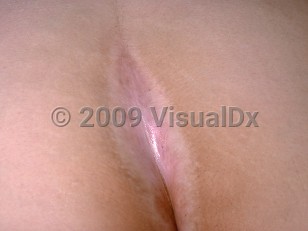Lichen sclerosus - Anogenital in
See also in: Overview,External and Internal EyeAlerts and Notices
Important News & Links
Synopsis

In children, it is the most common skin condition mistaken for sexual abuse. Although onset is typically around 35-45 years of age, about 15% of cases begin in childhood with onset between the ages of 3 and 7 years. It may be asymptomatic, although it often results in pruritus and burning, which at times can be incapacitating, leading to interference with daily activity and sleep.
Pruritus, pain on defecation, dyspareunia, dysuria, vaginal discharge, anal or genital bleeding, and/or constipation are common. Children may seek parental attention. They may also present with behavioral changes; for example, caregivers (teachers, parents) may describe a child as "always having their hands in their pants," "rubbing on everything," and "unable to sit still." Behavior caused by itching may be misinterpreted as masturbation that is persistent and resistant to requests to stop. There may be late progression to destructive scarring. Atrophic LS lesions of the vulva are often referred to as kraurosis vulvae.
LS commonly affects the vulvar and perianal skin, producing a "keyhole" area of hypopigmentation, often with scarring and loss of normal architecture. Lesions typically begin as white or yellow papules and can progress to white plaques with areas of atrophy, friability, and submucosal hemorrhage incited by only minimal trauma or irritation.
Misdiagnosis for sexual abuse most often occurs when the presentation is bullous, hemorrhagic, or erosive. Submucosal hemorrhages ("blood blisters") are rarely due to sexual abuse and are a common finding in LS. The presence of hypopigmentation, atrophic skin, and telangiectasias should help differentiate this condition from sexual maltreatment. Findings of confirmed sexual abuse are primarily associated with acute injuries to the genitalia, anus or oral cavity, genital scarring, sexually transmitted diseases, and hymenal transection or evidence of a deep notch. However, case reports of LS coexisting with child abuse or resulting from trauma associated with repeated sexual maltreatment have been documented.
Childhood sexual abuse is a problem of epidemic proportions affecting children of all ages and economic and cultural backgrounds. Although awareness is increasing, it is often challenging to differentiate findings attributable to child abuse from those of LS and other benign anogenital skin conditions.
Codes
L90.0 – Lichen sclerosus et atrophicus
SNOMEDCT:
895454001 – Lichen sclerosus
Look For
Subscription Required
Diagnostic Pearls
Subscription Required
Differential Diagnosis & Pitfalls

Subscription Required
Best Tests
Subscription Required
Management Pearls
Subscription Required
Therapy
Subscription Required
Drug Reaction Data
Subscription Required
References
Subscription Required
Last Updated:03/09/2023
 Patient Information for Lichen sclerosus - Anogenital in
Patient Information for Lichen sclerosus - Anogenital in - Improve treatment compliance
- Reduce after-hours questions
- Increase patient engagement and satisfaction
- Written in clear, easy-to-understand language. No confusing jargon.
- Available in English and Spanish
- Print out or email directly to your patient



